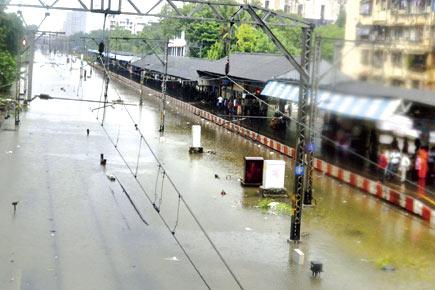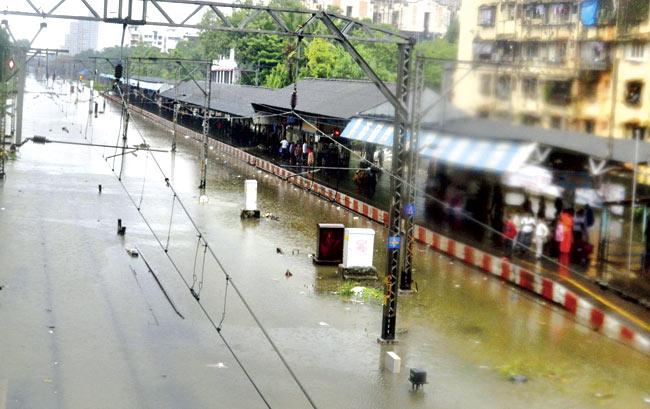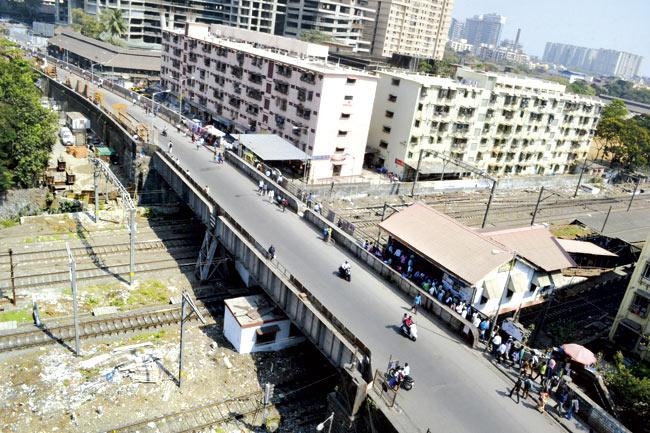Rail tracks at Currey Road, Matunga and Kurla have been depressed to enable conversion of overhead power lines from 1,500-volt DC to 25,000-volt AC; this increases chances of waterlogging

Currey Road Station
The conversion of overhead power lines from DC to AC will enable faster operation of trains, but may also cause waterlogging on Central Railway (CR).
ADVERTISEMENT

The flooded tracks at Currey Road station during last year’s monsoon
While CR has been converting the power lines from 1,500-volt DC to 25,000-volt AC, a problem arose for lines passing under the century-old bridges at several locations.
 Tracks were lowered by 7 cm at Currey Road. File pics
Tracks were lowered by 7 cm at Currey Road. File pics
A minimum gap had to be maintained between the bridge and the high-power cables after conversion. In order to fulfill this requirement, authorities had two options raise the stone-made bridges or lower the tracks to meet the criterion.
CR opted for the latter, easier alternative. Over the last 10-12 days, CR authorities have lowered tracks below road and foot-over bridges of Currey Road, Matunga railway stations, and at Kasaiwada, near Kurla station. This, however, puts the entire rail system on the main line of CR at risk of being affected due to flooding during monsoons.
Officials agree with this. “We are aware that the chances of flooding during monsoon are high and this could affect services as well. But we are left with no other option than to lower the tracks,” said a senior
CR official.
During heavy rains, there is waterlogging on tracks at several locations on the line — Parel, Currey Road, Sion-Kurla, Bhandup, Thane and a few locations beyond as well. Due to this, train services either come to a standstill or move at a snail’s pace. Commuters have a torrid time on CR every monsoon. Trains also tend to stand at the same spot for hours together as signals fail and there is also a risk of derailment and of other technical failures.
Sources said that the tracks at the three locations were lowered by 5-8 centimetres, depending on the requirement. At Currey Road, the tracks were depressed by 7 cm. Upgradation from 1,500-volt DC to 25,000-volt AC requires a buffer space of at least 21 centimetres between the train’s roof and the base of the bridges.
Toughest bridge last
mid-day had reported on April 1 that officials had inspected bridges at four locations to gauge the difficulty of carrying out conversion work (‘CR officials’ quandary: To raise height of bridges or lower the tracks’). The fourth location, below the Hancock Bridge near Sandhurst Road, is the trickiest of them all, due to its pitiable condition.
CR authorities are looking at options on how to deal with this bridge, and inspections will be done for the same. “We have lowered tracks near Currey Road, Matunga and Kurla stations. We will work on the Hancock bridge right at the end,” said Mukesh Nigam, divisional railway manager (Mumbai), Central Railway. One of the proposals is to demolish this bridge and replace it with a new one, which, if cleared, would be the BMC’s responsibility.
 Subscribe today by clicking the link and stay updated with the latest news!" Click here!
Subscribe today by clicking the link and stay updated with the latest news!" Click here!






